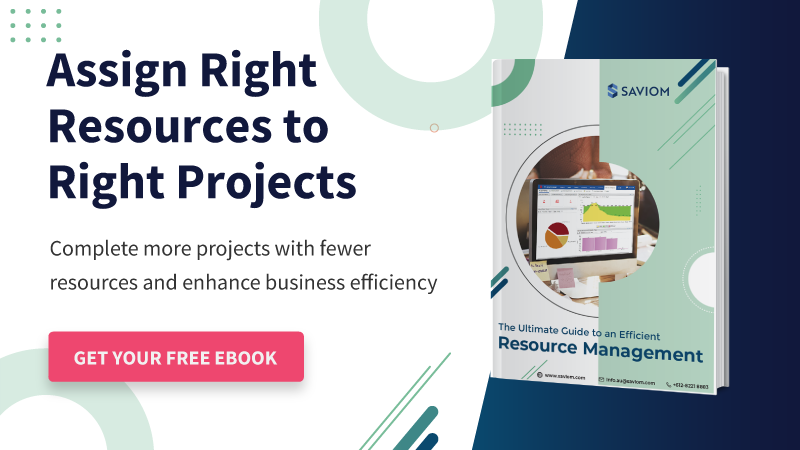Are you noticing a consistent decline in workforce engagement levels?
Unable to improve the billable resource utilization levels and profit margins?
Are your resources displaying low motivation and morale, resulting in high absenteeism?
If you answered yes to these questions, it signals potential underutilization of resources within your firm. If left unaddressed, this can lead to unplanned attritions, project disruptions, revenue loss, and other adverse impacts on the organizational health index.
Hence, it is imperative for organizations to recognize the various indicators of resource underutilization and take prompt action to combat them.
This proactive approach will enable them to achieve optimal resource utilization, ensuring business sustainability and profitability.
This blog focuses on signs resource underutilization signs and how project managers can mitigate the same using appropriate tools and techniques.
Before delving deep, let us get the fundamentals right and be productive.
What is resource utilization, and why is it important?
Resource utilization is a way to measure how effectively resources are used against their availability or capacity. It shows how productive your workforce is and also identifies where they are being over or underutilized. Thus, it helps prevent burnout and disengagement, improve productivity, and ensure even work distribution among team members. This fosters a healthier work environment but also enables the organization to unlocking the full potential of the workforce.
Furthermore, by understanding the utilization levels of resources, managers can analyze the current capacity and availability within the team. Accordingly they can anticipate if they require additional workforce to complete the pipeline projects. This foresight enables the organization to make informed decisions about hiring, training, or reallocating resources as necessary. It reduces last-minute firefighting of resources, expensive hirings, etc and ensures that the organization is well-prepared to take on new challenges and opportunities, contributing to long-term sustainability and growth.
Another significant advantage of resource utilization is the increased billability of resources. Managers can strategically mobilize team members from non-billable to billable tasks, maximizing the financial impact of each resource. This not only enhances the organization’s revenue streams but also contributes to the overall financial health of the company.
In essence, effective resource utilization becomes a critical factor in achieving financial success and business sustainability.
Knowing what is resource utilization and it significance, let’s understand how to calculate it.
Read More: What is Resource Utilization? A Complete Guide to Improve Business Efficiency
Resource utilization formula
For example, if a programmer works 8 hours per day and five days a week, his capacity is 40 hours. If he works 36 hours on billable work and the remaining 4 hours on non-billable work (BAU, admin work, etc.), we can calculate his utilization rate using the formula:
Resource Utilization = (Time spent on Billable Work / Total Capacity ) X 100 = (36 / 40) x100 = 90
In this example, less than 90% means underutilization, and more than 90% is overutilization. One must note that utilization rates must be a baseline for productivity and modified as per the company’s requirements. Project managers ensure that team members’ utilization is tracked, monitored, and rectified even after the initial resource allocation.
The absence of constant diligence, skill shortage, and lack of proper tools to efficiently manage resources contributes to the underutilization of resources.
This calculation helps you know the resources that are over/ underutilized. Let’s deep dive into undertanding what is underutilization of resources.
What is the underutilization of resources?
Underutilization of resources refers to a situation where available resources are not being fully utilized or employed efficiently to their maximum potential. It implies that there are idle or unused resources that could be utilized to generate additional output or value.
For example, In an IT project, if the actual capacity of a developer is 8 hours a day (ie. 40 hours a week) and is booked for 6 hours a day (ie. 30 hours a week), then the utilization rate will be 75%. This is a clear indication of underutilization where the employee is working less than the available capacity.
This can be due to an inefficient system to assign tasks based on individual skills and expertise, lack of career development opportunities, inadequate training and development, improper communication and collaboration among team members, etc.
Having understood what underutilization means, let’s learn what is the impact of underutilization.
Signs of underutilization of resources and effective methods to correct them
Organizations must be vigilant and take appropriate measures to prevent resource underutilization to remain profitable and sustainable amidst market volatilities. Some telltale signs of resource underutilization and how project managers can mitigate them using appropriate tools and solutions are:
Increase in bench time
When resources face more bench time, it adversely impacts your project’s profit margins. In IT companies, there is a continuous rise in workforce costs. In the absence of pipeline projects, companies risk landing up large bench resources with unplanned ramp-down activities. Since benched resources are non-billable, it adversely affects the organization’s bottom line.
How to fix:
Reducing bench time entails increasing billable or strategic hours. So, your teams can spend more time generating revenue, delivering projects on time, and generating more ROI per consultant. Having foresight into future project vacancies and knowing which resources will end up on the bench due to under allocation can help minimize bench time.
For this managers can leverage resource capacity planning to identify skill gaps and cross-train bench resources well in advance, to prevent last-minute firefighting for a competent workforce. In addition, forecasting billable utilization helps mobilize resources from non-billable to billable work, thereby, encouraging resources to develop more than one skill improves billability.
Read More: Maximize Profitable Resource Utilization with Modern Resource Management Solution
Frequently missing project deadlines
Constantly struggling to get tasks on track or failing to deliver projects on time jeopardizes your business’s reputation and customer confidence. Missing project deadlines can stem from not having a feasible project plan in the first place without clearly defining the roles and responsibilities of each team member contributing to the project. In addition,
Lack of correct competent allocation can be a significant contributor to missed project deadlines, budget overruns, and lower productivity levels.
How to fix:
Multidimensional resource scheduler helps assign appropriate resources to suitable opportunities. It minimizes the allocation of under or over-qualified resources to projects. In addition, gantt chart view provides clarity on who is working where and how long on various tasks. It helps project managers to ensure that the right team members are appointed and deployed on tasks until completion. Subsequently, the timelines and work required to keep them on track do not veer off, enabling timely delivery.
Read More: 7 Powerful Benefits of Resource Scheduling for Project Managers
Low billable utilization in a shared services model
Shared Services Model is a business setup that leverages resources across the enterprise with agreed-upon customer-service levels for cost reduction initiatives.
Deloitte Global Cost Survey 2020 states that, “Post Covid, the likelihood of cost reduction initiatives increased by 74%.”
In this model, the project co-coordinator tends to allocate tickets to a handful of selected high-performing employees. As a result, some of the team members, particularly the new ones, remain underutilized. If there is a gap in skill set, providing ample training on the job or shadowing opportunities empower new members to work independently. Otherwise, it can cause over-utilization of some resources while others remain underutilized.
How to fix: Resource Management tool captures resource information on a single platform. Using advanced filters like location, qualification, experience, skills, cost, availability, and more, managers can identify resources meeting the minimum qualification criteria. Instead of overloading few critical resources, members who fulfill the minimum requirement can work alongside these high performers and receive training on the job. It helps project managers maximize billable or effective utilization across the enterprise without causing over or underutilization.
Decreased employee engagement and productivity
Studies have shown that a heavy workload is less stressful for employees than less work. Underutilized employees can feel undervalued, unproductive, and bored, inhibiting their creative side. It also adversely impacts their commitment towards a task and reduces overall business productivity. Decreased employee satisfaction can affect how resources approach their work and cause detrimental effects across the organization.
How to Fix:
In a survey by Salesforce, it came to light that,” Employees who feel heard at their workplace are 4.6 times more empowered to put forward their best work. “
Frequently conducting employee engagement and satisfaction surveys helps garner employees’ opinions on possible improvement areas, including optimizing their utilizing levels. Managers can leverage forecasting capabilities of a resource management tool to analyze the skill gap ahead of time.
Accordingly, reskilling and upskilling resources can mitigate the risk of employee dissatisfaction. Allocating work based on employee’s skills and interests facilitates task ownership and boosts employee engagement. Actionable insights derived from real-time business intelligence and reports can result in streamlined and persistently higher utilization rates for all resources.
Read More: What is Resource Forecasting? An Ultimate Guide for Project Managers
Employee burnout and high turnover rates
Sometimes project managers tend to assign more tasks to a few critical resources who have delivered results in the past. Frequently overloading resources with work causes employee burnout, fatigue, and unplanned attrition. Low resource utilization usually happens when underutilizing some team members at the cost of overutilizing others.
Improper resource allocation results from underutilizing potential and increasing bench-time or overloading the existing team by adding more tasks into their workload. This uneven workload distribution can lead to faster burnout rates and subsequent turnover in specific departments, teams, and positions, sabotaging teams taking more work than their capacity.
Overallocation typically happens when a resource is simultaneously working on multiple projects within a shared services model. So, it is essential to track the overloaded resource’s activities regularly so that he/she does not land up spending more time on one specific project.
Assigning critical resources to only high-priority projects causes budget and schedule overruns of other projects. Based on the task priority and deadline, resource scheduling and planning tools help edit an existing resource booking or create a new one with easy drag and drop functionality.
How to fix: Using resource optimization techniques like resource leveling, project managers can minimize over or underutilization and match work against the staff capacity. Multidimensional resource schedule helps to make the right resources available with the right skills at the right cost and time.
Providing these resources with on-the-job training will help fill critical positions, thereby eliminating the need for overloading. Resource capacity planning helps identify the skill gap and helps build an on-demand workforce to smoothen the workload, restoring balance in your workforce schedules.
Read More: Resource Allocation: A Guide on How to Apply it to Project Management
Employees possessing unutilized skills
In organizational settings, sometimes critical information is lost in silos , hindering managers from gaining a comprehensive visibility into the skills and capabilities of their employees. Without this knowledge, it becomes challenging for managers to effectively leverage the skills of the workforce .
As a result, even when though individuals possess specialized expertise or talents, their skills may go untapped, lying dormant within the organization. This underutilization not only impacts the job satisfaction and motivation of the employees but also carries broader implications for the organization as a whole. When employees remain idle for an extended period, it enlarges the bench capacity and diminishes return on investment, leading to decreased profitability.
How to fix:
To mitigate this, organizations can leverage an advanced resource management solution offering comprehensive visibility into various attributes such as skills, competencies, and availability. Additionally, the competency matrix within the tool aids managers in assessing and understanding the evolving skills of their team members. It will empower managers to efficiently allocate competent resources to projects that align with their expertise. Further the tool also provides real-time utilization report, which will enable managers to identify underutilized resources promptly and implement measures to enhance efficiency
Additionally, organizations can also perform skill assessments and provide opportunites to for professional development. It helps employees acquire new skills and find tasks for applying their expertise within the organization. This will help, firms enhance employee satisfaction, increase productivity, and unlock untapped potential for innovation and growth.
The takeaway
Resource utilization is an essential KPI for most organizations, and achieving optimum resource utilization is the key to enhanced efficiency, productivity, and ROI. To enhance workforce productivity, managers must ensure that resources are neither under nor overutilized against their capacity. So it’s time to replace clunky spreadsheets and homegrown tools with robust resource management software to take care of your resource managing and scheduling needs.
The Glossary
Read More: Glossary of Resource Workforce Planning, Scheduling and Management
SAVIOM Solution
SAVIOM is the market leader in offering the most powerful and configurable solutions for deploying appropriate resources to suitable projects. With over 20 years of experience, this Australia based MNC has helped more than 100 clients across over 50 countries address specific business challenges. SAVIOM also provides tools for project portfolio management, professional service automation, and workforce planning software.












